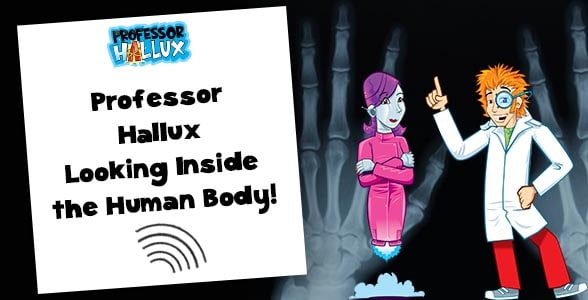
Body has swallowed Professor Hallux’s keys to the fridge, after hearing Nurse Nanobot tell him he needed more iron in his diet! Whoops!
Now Body isn’t very well and he’s in lots of pain! The only thing is, they need to know exactly where the keys are in Body’s body, and they need some cool gadgets to help.
Professor Hallux, Nurse Nanobot and Body have made their way to the Imaging department at their local hospital where there’s lots of different types of radiology to see inside a body, and lots of different machines.
You can diagnose lots of different types of diseases and injuries with radiology, one of those is head injuries.

Now Body has real trouble staying still. Because he was messing about in the waiting room chair, he’s knocked over Nurse Nanobot and she’s hit her head! Nurse Nanobot is feeling a bit confused and dizzy, her pupils are big and she’s just fainted! These are all classic signs of concussion, which is sometimes what happened when you have a head injury..
Head injuries are a very common reason for people to have a scan at a Radiology department. But unlike Nurse Nanobot, they can’t be examined with a spanner and a tin of oil.
There’s two types of head injuries:
- closed ones when the skin isn’t broken
- penetrating ones when the skin or bone is broken
Sometimes it’s obvious straight away if something is wrong but other times it can take a little while for symptoms to start to show. Sometimes it takes a few days!
While patients with minor head injuries may be observed and treated with medication, more serious traumatic brain injuries may require emergency care to remove blood clots or relieve pressure on the brain.

Symptoms are clues that hitting your head may have caused problems inside your skull! Being dizzy and feeling sick and confused are symptoms of concussion.
- If the pupils in the middle of your eyes dilate (that’s the black bit), that could be a sign of Internal Bleeding – that’s when there maybe bruising of the brain tissue and swelling within the skull.
- Now, if anyone has any symptoms like these and has hit their head, they should be seen by the doctor as soon as possible, because although usually everything settles back down to normal, some head injuries can be very serious!
There are several types of head injury:
Concussion – also called a mild traumatic brain injury. This includes injuries to the brain that are caused by a blow to the head or body, a fall, or another trauma that jars or shakes the brain inside the skull. People who suffer from concussions may not always exhibit symptoms that are apparent to others. Symptoms include:
- loss of consciousness for a few seconds to a few minutes
- confusion; memory and/or concentration problems
- dizziness
- headache
- memory loss (amnesia) of events before the injury or immediately after it
- nausea and vomiting
- altered level of consciousness, such as being drowsy or difficult to awaken
Contusion – is a bruise of the brain tissue often associated with swelling and an increase in pressure within the skull. Symptoms include:
- dilated pupils
- high blood pressure
- low pulse rate and abnormal breathing
Fracture – a crack or break in the skull, with or without a laceration to the skin. Symptoms include:
- tenderness
- swelling
- skull deformity
- bruising around the eyes or behind the ear
- clear fluid leaking from the nose or ear
Bleeding – also called a hemorrhage, is a potentially life-threatening condition and in many cases may require urgent attention by a neurosurgeon. A brain hemorrhage occurs when a blood vessel in the brain bursts, causing bleeding into surrounding tissue, swelling and increased intra-cranial pressure. Blood may also collect and form a clot, called a hematoma. Symptoms include:
- sudden severe headache
- seizures
- nausea or repeated vomiting
- lethargy (tiredness)
- weakness in an arm or leg
- loss of consciousness
Scans in the radiology department will be used to help figure out how bad an injury is. You’re most likely to have a CT or MRI scan. The simple black and white type of X-ray you would have for a broken leg is unlikely to be used because it doesn’t give as much detail – and brains are very complicated things!

- A CT scan will produce lots of images to make a detailed picture of the head and brain. It’s a really great way to see if there’s any bleeding, swelling injury to the brain or skull fractures.
- You might have a MRI scan to get a very detailed picture, and that’s extremely useful when the problem isn’t easily detected.
Click here for a virtual tour of a real Imaging Department!
Click on a topic below to explore more radiology!
[related tag=”radiology”]


